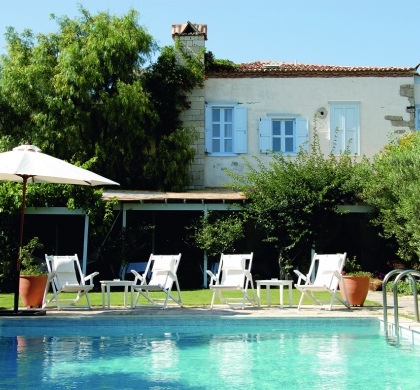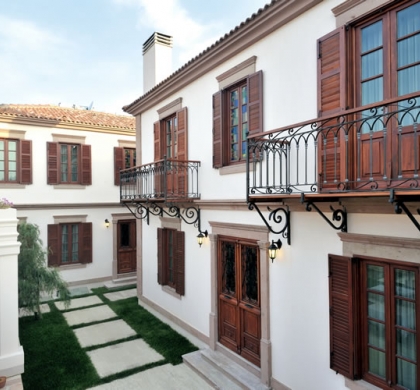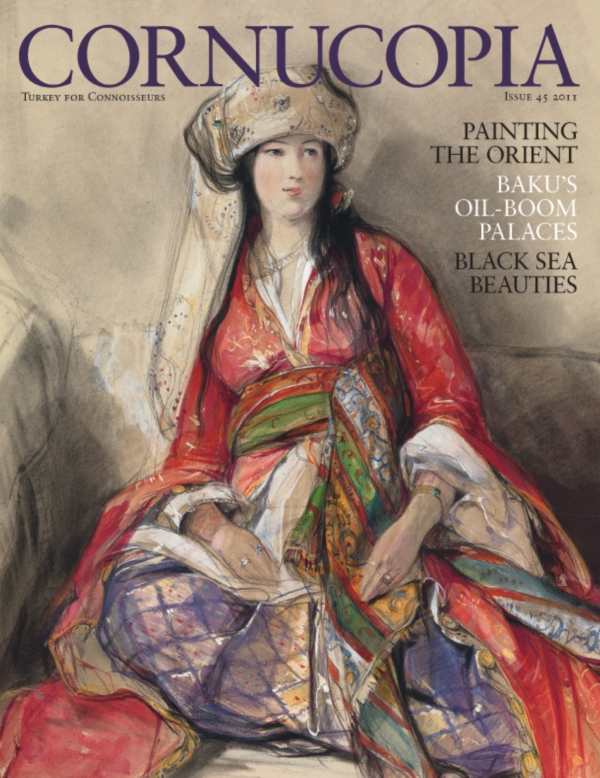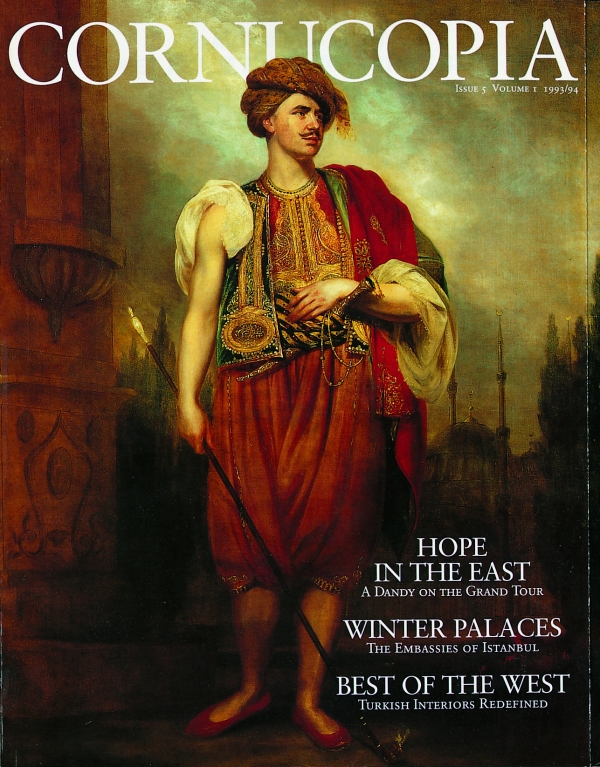Buy or gift a stand-alone digital subscription and get unlimited access to dozens of back issues for just £18.99 / $18.99 a year.
Please register at www.exacteditions.com/digital/cornucopia with your subscriber account number or contact subscriptions@cornucopia.net
Buy a digital subscription Go to the Digital EditionAn antiquarian’s deliciously distressed house in the Aegean was the first port of call for Berrin Torolsan when she set out to write the text for an inspiring new book on Turkish interiors. In this extract from At Home in Turkey, with photographs by Solvi dos Santos, she is captivated by a low-key restoration.
Selden Emre’s grand house on the island of Cunda, which once belonged to a Christian priest, dates back to the beginning of the 19th century. In its day it was one of the town’s most prestigious houses, located on the hill next to the basilica on a corner known as Merdibanli Sokak – the street with steps.
Cunda, off the coast of Ayvalık in the northwestern Aegean, is a small island attached to the mainland by a causeway. The largest of twenty or so islands in an archipelago that forms a lace-like pattern on the Aegean coastline, Cunda is the only one that is inhabited. With its magnificent views and scented breezes blowing down from Mount Ida, it has always been a popular retreat. The island’s architecture suffered in troubled times: the riots and civil wars of the final days of the Ottoman Empire were followed by a massive earthquake in 1944. But elegant 19th-century Neoclassical features are still visible everywhere.
Selden is a brilliant antiquarian with a keen eye for exquisite objects. Her three-storey house dominates its neighbours but is not ostentatious. It has been beautifully and faithfully restored to its former grandeur, yet in no way is it at odds with the other old houses in the neighbourhood, all of which are listed, and no fewer than 551 of which are under conservation by the state. The pale pistachio green of the exterior paintwork marries happily with the wooden shutters, the white detailing, the exposed stonework of the arched doorway.
Old architectural features, which often also prove to be clever practical solutions, are still in use. For example, rainwater is collected from the roof and channelled through zinc gutters and pipes into the cistern in the basement. Nowadays there is a city water supply, and if there are any water shortages one can order a tanker. But, as Selden says, “Why not use a perfect ecological system that already exists?” As a result, all year round she enjoys the softest of water. “Rainwater is free, and it makes your hair silky, the laundry soft and your plants happy.” All she did was install a small pump to bring water to the upstairs bathrooms. During the entire restoration concrete and synthetic materials were avoided. The thick stone walls, often lime-plastered and limewashed, and the wooden ceilings and floorboards all help to keep the house cool in the summer months, making air conditioning unnecessary.
An elegant arched doorway with massive oak doors opens into a spacious hall with chequered black-and-white flagging salvaged from another old building, the frosty patina of age sage greens, faded mauves and soft creams is enlivened by a vivid velvet nursing chair next to the fireplace. On the garden side of the hall is a raised platform, under which stands the cistern, filled to the brim with rainwater. On this platform, where the kitchen was originally located, is a second well-used fireplace with its original hearth, a sofa and a dining-cum-working table, all offering inviting corners to rest, work or just contemplate. Selden’s three cats also seem to be most at home here. Beyond is a very small, bright kitchen with a charming balcony, a later addition, where breakfast can be taken. From the platform one also has access to a little veranda, where most summer afternoons are spent and from which stairs lead down to a delightful walled garden, lovingly lined with pots and containers of sweet basil, old-fashioned roses, fragrant lemon geraniums, jasmine and clove-scented pinks.
A wrought-iron staircase with wooden steps – one of the few modern features of the house – takes one up to two rooms on the first floor, separated by a landing. The ceilings are lower here, as these were originally the winter rooms traditional in all Ottoman houses; sandwiched between two floors, they were warmer and easier to heat in winter. The shutters in these rooms are inside, so that they can be easily closed on stormy evenings. Selden has converted them into delightful guest bedrooms. All the cupboards, shelves and niches have been preserved, offering not only generous storage, but also handsome partitions, even concealing a bathroom in one of the rooms. All the timber elements are painted a distressed sage green.
The lath-and-plaster second floor overhangs the street, jutting out over the strong stone walls of the two lower floors and resting on delicate iron consoles. The rooms on this floor have magnificent views from every window, even the bathrooms. Selden reserved the two larger adjoining rooms as her bedroom and boudoir. The latter has a vaulted ceiling with plaster cornices and was presumably once the main reception room of the house. The ceiling has traces of painted decoration, and the walls are inlaid with small wooden plaques which would have enabled the owners to hang curtain rails above the windows and numerous heavy-framed paintings around the room without damaging the plasterwork.
Selden has a fine touch: the colours, furniture and objects she has chosen all have a poetic, uncontrived feel. The restoration may have taken two years to complete, but it looks as if it was effortlessly achieved.
When it was built in 1741 in the new Baroque style, Cağaloğlu was at the forefront of architectural fashion. But this temple of cleanliness in the Old City marks the dramatic swansong of the grand Ottoman hammam.
Bodrum’s peace was shattered in 1856 by the arrival of a warship bearing one of the most ambitious archaeological expeditions Britain has ever launched. Leading it was Charles Newton. His mission was to locate, excavate and carry home one of the Seven Wonders of the Ancient World
Although commonly regarded as a root vegetable, like the potato, carrot or turnip, the bulbous part of the celeriac plant is not actually the root but a corm, the base of the leaf stems, out of which modest roots will grow.
More cookery features
On the tiny island of Bozcaada (Tenedos), a mere speck in the Aegean, great wines are emerging that rival the best the world can ofer. The Corvus vineyards, once among the Mediterranean’s most celebrated, have suffered centuries of neglect. Kevin Gould raises a glass to their renaissance with the founder of Corvus, Resit Soley. www.corvus.com.tr
See Cornucopia’s self-guided wine tour
Another masterpiece by the imperial architect Sinan, the Cınılı Hammam in the Old City of Istanbul was built for the legendary corsair-turned-admiral Barbaros Hayrettın Pasha, or Barbarossa, in the 1540s. Today it is far from grand, and only a few of the tiles that gave it the name Çınılı (Tiled) are still in evidence. But nothing can diminish the effect of the soaring curvy arches supporting a series of imposing domes.





Cornucopia works in partnership with the digital publishing platform Exact Editions to offer individual and institutional subscribers unlimited access to a searchable archive of fascinating back issues and every newly published issue. The digital edition of Cornucopia is available cross-platform on web, iOS and Android and offers a comprehensive search function, allowing the title’s cultural content to be delved into at the touch of a button.
Digital Subscription: £18.99 / $18.99 (1 year)
Subscribe now